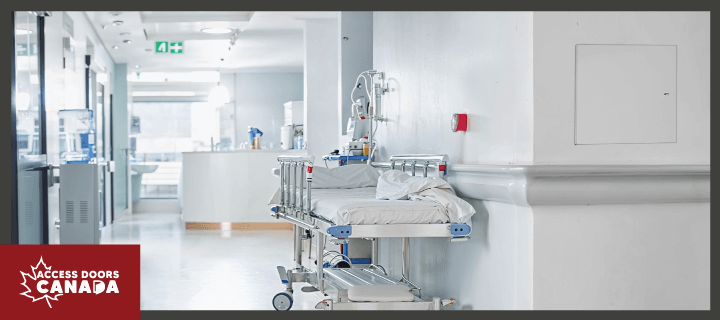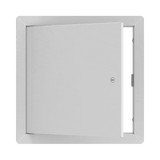How Insulated Access Doors Reduce Heating Costs in Canadian Commercial Buildings
Canadian winters can be brutal, especially when managing a commercial building. With heating systems running around the clock to keep things warm, energy bills can quickly spiral out of control. You've likely made the usual upgrades—insulation, windows, doors—but those drafts still seem to sneak in.
So, what's the real issue? Uninsulated access points. Those often-overlooked hatches leading to mechanical rooms, rooftops, or storage areas might seem small, but they can be major contributors to heat loss and unnecessary energy waste.
The good news is that insulated access doors are a simple, effective solution. They are designed to seal in heat, minimize energy loss, and keep heating costs in check.
In this blog, we’ll take a closer look at how insulated access doors work and why they should be a top consideration for any commercial property looking to improve energy efficiency this winter.
Understanding Heat Loss in Commercial Buildings
Heat loss is a critical issue that impacts commercial buildings' energy efficiency and operational costs. As temperatures drop, the demand for heating systems increases. Without proper insulation, a significant amount of heat can escape.
The Problem of Heat Loss
Heat loss happens when warm air escapes through poorly insulated building areas. Common problem areas include windows, doors, and hidden access points like hatches and maintenance doors.
Even small gaps or cracks can let a surprising amount of heat escape, forcing the heating system to work harder to keep the building warm. This extra pressure on the system increases energy use, leading to higher costs over time.
Climate Challenges in Canada
Canadian winters create serious challenges for building insulation.
With temperatures often dropping below freezing, buildings must keep heat in and the cold out to avoid wasting energy. In regions where the cold lasts for months, the pressure on insulation is even greater.
Insulated access doors in Canada provide an effective solution by helping to seal these areas and reduce energy loss.
What Are Insulated Access Doors?
Insulated access doors are specially designed doors that help prevent heat loss in commercial buildings. These doors feature a layer of insulation, typically made of materials like polyurethane cores, which are known for their excellent thermal properties.
The doors also have thermal seals around the edges to minimize drafts and enhance energy efficiency. Their design ensures they act as barriers to heat escape, keeping warm air inside while blocking the cold from getting in.
One example of an insulated access door is the ADC-PAL Insulated Aluminum Access Door. Made from high-quality aluminum, this door is highly corrosion-resistant, making it ideal for areas where moisture or humidity is a concern. It has a 1-inch fiberglass insulation core to keep heat in and a neoprene gasket to help reduce sound between rooms.
How ADC-PAL Insulated Aluminum Access Door Can Help
- Prevents Heat Loss: The 1-inch fiberglass insulation core helps maintain consistent indoor temperatures, reducing the need for the heating system to work overtime.
- Enhances Energy Efficiency: By reducing energy and heat loss, the ADC-PAL door contributes to lower energy consumption, reducing overall heating costs.
- Durable in Moisture-Prone Areas: Made with corrosion-resistant aluminum, the door is ideal for installations with high moisture or humidity, such as mechanical rooms or water supply valves.
- Sound Insulation: The neoprene gasket reduces unwanted sound transmission between partitions, improving acoustics within the building.
- Security and Accessibility: Equipped with a cylinder lock key, it ensures both security and easy access to critical areas of the building.
If you're looking for more insulated access door options, visit Access Doors Canada. We offer many high-quality solutions to improve energy efficiency and help you maintain comfortable indoor temperatures in your commercial building.
How Insulated Access Doors Mitigate Heat Loss
Let’s break down how insulated access doors work to keep your building warm and energy efficient.
Thermal Insulation Technology
Insulated access doors are designed with materials that trap heat inside. The insulation inside the door—like fiberglass or foam—helps to stop heat from escaping. The "R-value" measures this, which shows how well the material resists heat flow.
The higher the R-value, the better the insulation works. So, using these materials, the doors keep the warm air in and the cold air out, making it easier to maintain the right temperature inside the building.
Sealing Mechanisms
In addition to insulation, most insulated access doors in Canada have special gaskets or seals around the edges. These seals act like weatherstripping for the door, blocking any gaps that could let drafts in. With tight seals, the door becomes a solid barrier against heat loss.
Economic Benefits of Insulated Access Doors
Here’s how these doors can save money and add value to your property:
Lower Heating Costs
One of the biggest economic benefits of insulated access solutions is the reduction in heating costs. In commercial buildings, where heating systems often run constantly during harsh winters, even small improvements in insulation can lead to big savings.
For example, adding insulated doors can cut energy use depending on the building's size and climate. In cold regions like Canada, where temperatures often drop below freezing, this can result in thousands of dollars saved each year on energy bills.
Return on Investment
While insulated access doors may have a higher upfront cost than standard doors, the long-term savings make them a smart investment. By reducing the workload on heating systems and cutting down on energy consumption, these doors pay for themselves over time.
In fact, many commercial buildings start seeing a return on investment within 2-3 years due to lower heating costs. After that, the savings continue yearly, improving the building's overall financial efficiency.
Increased Building Efficiency
Insulated access doors play a significant role in improving the overall efficiency of a commercial property. These doors help buildings meet energy efficiency standards by reducing heat loss and improving temperature control.
As a result, they contribute to a building’s sustainability goals and can even make it eligible for green building certifications. Furthermore, by preventing drafts and temperature fluctuations, they reduce wear and tear on heating systems, which leads to fewer repairs and longer system lifespans.
Enhanced Property Value
By improving energy efficiency, insulated access doors can increase the value of a commercial property. Buildings with better insulation and lower energy costs are more attractive to buyers and tenants who prioritize sustainability and reduced operating expenses.
Investing in these doors not only saves money on utilities but can also make the property more competitive in the market, leading to a higher resale value or more desirable rental rates.
Conclusion
Insulated access doors are an important investment for any commercial building in Canada. They help reduce heating costs, improve energy efficiency, and offer long-term savings.
At Access Doors Canada, we offer a variety of insulated access doors designed to reduce heat loss and improve energy efficiency in commercial buildings. Our products help you maintain optimal temperatures while lowering heating costs, making your building more sustainable and cost-effective.
Get a free quote today to find the best products for your project needs. For more tailored advice and expert guidance, feel free to call us at (800) 679-3405. Let us assist you in enhancing energy efficiency and creating a comfortable, sustainable environment.









